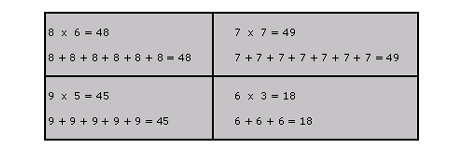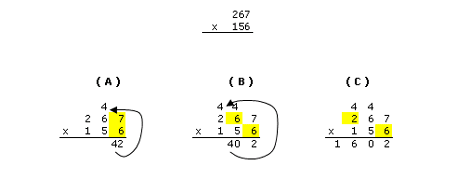Multiplication Teaching Material
Multiplication Instruction

The above two equations have the same value and are very straightforward. It is important to know that the order of numbers makes no difference in multiplication (or addition). For example:

Multiplication, simply put, is adding groups of numbers. For instance, in the above example, the number 8 is being added six times.

It will be difficult to pass a police exam if you have to calculate all simple multiplication in this manner. You should memorize the basic multiplication tables through to twelve. Review the multiplication table in this book.
Some complications arise when larger numbers are used and you need to carry numbers.
Example

(A)
Begin by multiplying out the right row. The 2 is recorded in the right column and the 4 is transferred to the middle column and recorded as above.
(B)
The second step is to multiply the 6 in the middle column. 6 x 6 = 36. The 4 that was carried over from step A has to be added to the 36. The result is 40 and the 0 is recorded in the middle column. The four is then carried forward to left column as in step A.
(C)
The 6 then has to be multiplied to the left digit on the top number. 6 x 2 = 12. The four that was carried over from step B is added to the 12. The result is 16 and recorded as shown.

(D - F)
The next steps are to multiply the second digit in the bottom row (the 5) to each of the top digits. The 5 is multiplied to the 7, the 6 and the 2. The process is the same as steps A - C. If the number is 10 or larger the number is carried over, as above and added to the next multiplication.
It is important to remember that the next multiplication set has to be recorded on the line below and lined up starting in the next column. Place a zero in the right column to ensure the digits line up properly.

(G - I)
The next steps are to multiply the left digit in the bottom number by each of the digits in the top number. The same process is used as outlined as above if numbers have to be carried over.
Lining up of the digits is also necessary at this stage. Because you are multiplying from the hundreds column (the left most) you begin recording the answer in the hundreds column. Follow the same procedure as outlined above. Fill in the first two columns with zeros.

The final step is to add up the three numbers that were multiplied out. Treat the addition of these three numbers exactly as you would a regular addition problem. If you failed to line the numbers up properly, you will wind up with an incorrect answer. 41,652 is the final answer.
Note: Because complex multiplication questions (like the one above) involve addition, make sure you have a firm grasp of the addition section before trying to tackle multiplication.
Things to Watch For
Watch out for a multiplication question where the first digit in the bottom number is a zero, or where there are zeros in the equation. You still have to properly line up the digits. Note the highlighted zeros.

Remember that zero multiplied by any other number is zero. In this situation you begin multiplying with the 10's column (the 5). Because you are multiplying from the 10's column, you begin recording your answer there. Place a zero in the first column.

When the four is multiplied to the 0, the result is 0. The number, which is carried over from multiplying 9 x 4 has to be added to 0, which results in the highlighted answer - 3.

In this situation there is no need to multiply the bottom ten's digit out, as the result will equal 0. You must, however, properly line up the numbers. Because the 3 is in the hundred's column, you must begin recording your answer in the hundred's column. That is why there are two highlighted zeros.
Multiplying with Decimals
Multiplying with decimals is a fairly simple process. Simply follow the same rules for multiplying as outlined above. After you have reached a conclusion you then determine
where you place the decimal point. Simply count the total number of decimal places their are in the question, and make sure there are an equal number of decimal places in the final answer.
In example (A) below, there are two decimal places in the top line of the question, and one in the bottom for a total of three decimal places. In the final answer there also has to be three decimal places.
In example (B) below, there are three decimal places in each of the numbers for a total of 6 decimal places. In the final answer there also has to be 6 decimal places.
Finally in example (C) there are only two decimal places, so the final answer only has two decimal places as well.

Peer Support
If you are having difficulty with the subject matter, there is always a great deal of support available to you from other members through the Forum. Simply do a search for the material you need help with (math, algebra, integers, etc.) Members are very supportive and helpful. Don't hesitate to post any questions, or provide answers to others seeking assistance.
Multiplication Practice Tests
Work through the following tests to make sure you are comfortable with the material.




Practice Questions
Try these practice questions. The answers are posted below.
a) 18 x 9 =
b) 26 x 14 =
c) 98 x 41 =
d) 77 x 76 =
e) 102 x 21 =
f) 252 x 73 =
g) 721 x 125 =
h) 187 x 214 =
i) 82 x 99 =
j) 921 x 126 =
k) 8.77 x 13 =
l) 1.33 x 0.663
m) 6.32 x 100
Answers
a) 162
b) 364
c) 4018
d) 5852
e) 2142
f) 18396
g) 90125
h) 40018
i) 8118
j) 116046
k) 114.01
l) 0.88179
m) 632

